UNESCO World Heritage
What does it mean to be a UNESCO World Heritage Site?
In 1987, Lübeck's Old Town with its historic city centre was awarded the title "UNESCO World Heritage Site" and bears this distinction together with other world-famous sights such as Machu Picchu in Peru, the Pyramids of Giza in Egypt or, for example, the Taj Mahal in India. This is the first time in northern Europe that an entire old city has been recognised as a World Heritage Site. But what exactly does this mean?
The criteria for recognition as a cultural world heritage site were (and still are) the distinctive townscape with its seven church towers reaching into the sky and the closed, preserved pre-industrial building fabric. Lübeck's medieval Old Town is an outstanding example of brick Gothic and reminds us of its past as an early centre of world trade.The exemplary character for the Hanseatic League in the Baltic Sea Region was and is also an important criterion.
Lübeck was founded as the first occidental city on the Baltic coast in 1143 and laid out in 1159 under Henry the Lion in the basic lines that continue to have an effect until today. The core of the city's architecture are the structures built in the High Gothic period; typical features are the parcelling, the lining up of similar gabled houses, roof structures or high gables.
The Old Town, surrounded by water, recounts 1,000 years of living history. For centuries, the name of the city sounded like freedom, prosperity and justice. And even today, many examples of the Gothic, Renaissance, Baroque and Classicist architectural monuments, the narrow alleys, passages and paths, churches and monasteries, town houses, craftsmen's courtyards and fortifications recall Lübeck's heyday.
In order to preserve these old monuments, including the churches and their towers, for future generations, it is important to act quickly as soon as damage to buildings becomes apparent. Therefore: "I want to see seven towers!”



